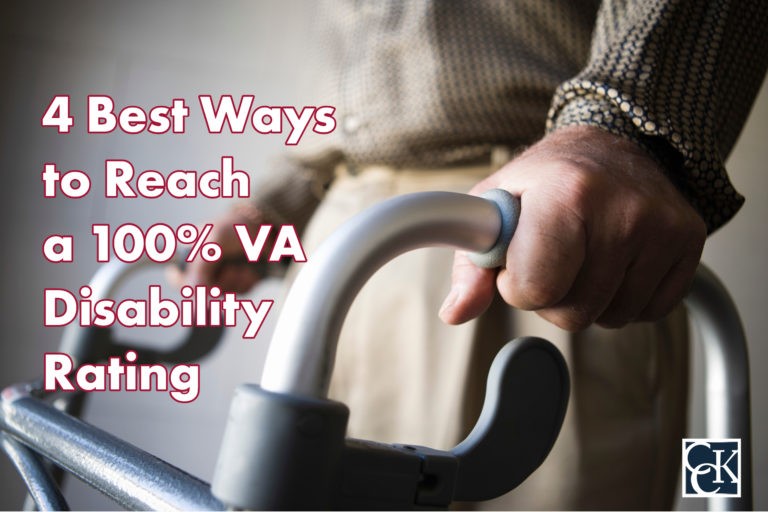4 Best Ways to Reach a 100% VA Disability Rating

Veterans rated at 100 percent receive the highest percentage rating VA offers for service-connected disabilities. Continue reading to learn more about the ways veterans can reach a 100 percent VA disability rating.
What Does it Mean to be 100% Disabled?
As mentioned above, a 100 percent disability rating, or a total disability rating, is the highest percentage that can be given for service-connected compensation purposes. This rating is reserved for veterans with extremely debilitating service-connected conditions that typically make them unable to work and mostly unable to care for themselves.
Compensation for 100% VA Disability Ratings
VA disability ratings are meant to compensate veterans for the average impairment in earning capacity caused by their service-connected condition(s). Generally, the more severe a disability is, the higher the VA disability rating will be and the more compensation the veteran will receive.
A 100% VA disability rating has the highest monthly compensation rate.
Veterans with a 100 percent disability rating and no dependents currently receive $3,737.85 per month.

How Can I Get a 100% VA Disability Rating?
Direct Service Connection
Before receiving a VA disability rating, veterans must first establish service connection for their claimed condition(s). Direct service connection generally involves the following three elements:
- A current, diagnosed condition;
- An in-service event, injury, or illness; and
- A medical nexus linking the current, diagnosed condition to the in-service occurrence.
Evidence such as service medical and personnel records, lay statements, and opinions from doctors can be submitted in support of a veteran’s claim.
Veterans can file for service connection for multiple service-related conditions. If granted service connection, each condition will receive a separate disability rating ranging from 0 to 100 percent.
- Ratings are added using VA math to determine a combined disability rating
- It is important to point out that combined ratings do not exceed 100 percent
To file for direct service connection, veterans should fill out and submit VA Form 21-526EZ – VA’s application for disability compensation and related compensation benefits.
Veterans may do so online using the eBenefits portal, by mail, in person at their local Regional Office, or with help from an accredited veterans’ advocate or attorney.
Secondary Service Connection and Aggravation
A secondary service-connected disability is a disability that resulted from a condition that is already service-connected. In these claims, proving a nexus is especially important. Aggravation is when a pre-exiting condition was made worse, or aggravated, by military service.
A nexus is a medical opinion that, in cases of secondary service connection, links a veteran’s secondary disability to their already service-connected disability. The link between disabilities must be clearly established to be granted secondary service connection for the disability.
Examples of common secondary conditions include:
- Peripheral Neuropathy Secondary to Diabetes Mellitus Type 2
- Radiculopathy Secondary to Back Disabilities
- Depression Secondary to Parkinson’s Disease or Cancer
- Depression and Anxiety Secondary to Orthopedic Pain
Filing a secondary VA claim for service connection involves the same process as filing any other initial claim. If granted service connection, the secondary condition will be rated in the same manner as other service-connected conditions.
Again, VA math will be used to determine a combined rating. This may be another way for veterans to reach a 100 percent rating.
TDIU
TDIU, or total disability based on individual unemployability, is a benefit that allows veterans to be compensated at the 100 percent level, even if their combined disability rating is less than that.
In this way, it is an alternative path to receiving maximum benefits
TDIU is awarded in circumstances in which veterans are unable to secure and follow substantially gainful employment as a result of their service-connected condition(s). VA outlines two ways in which veterans can pursue TDIU: schedular and extraschedular.
To qualify for TDIU under 38 CFR § 4.16(a), or schedular TDIU, a veteran must have:
- One service-connected condition rated at 60% or higher; or
- Two or more service-connected conditions, one of which is rated at 40% or higher, with a combined rating of 70% or higher.
Veterans who do not meet the schedular requirements under 38 CFR § 4.16(a) may still be considered for extraschedular TDIU under § 4.16(b).

File an Increased Rating
The disability rating VA assigns in its initial rating decision may be satisfactory at the time; however, your condition may worsen years later.
If you are outside of the one-year period to file an appeal challenging VA’s decision, you will likely have to file a new claim for an increased rating. VA will treat this as any other claim and issue a rating decision in response.
You can submit any new documentation or evidence you have to prove that your service-connected condition has worsened.
In the legacy appeals system, the evidence must be “new and material,” whereas under AMA, it must be “new and relevant.”
Veterans should also be mindful of the rating criteria for the service-connected condition for which they are seeking an increase. They can determine how their symptomology lines up and can have private doctors opine on the severity of their conditions in relation to what is listed in the rating criteria.
Tips for Obtaining a 100% Rating
- Use lay evidence, such as buddy statements or statements from family, friends, coworkers, etc. to bolster your VA claim. This can help to fill in the gaps that medical evidence misses.
- Attend your C&P exams. VA may deny your claim outright if you do not attend the exam.
- Be honest and do not downplay your symptoms. Do not overexaggerate, as it may be noted as “malingering.”
- If the results of your C&P exam are not favorable, you can introduce new medical evidence or even challenge the exam.
- Look at the reasons for which VA denied your claim to spot any errors.
- If you believe your rating is too low, continue to appeal your decision. While the VA process can be long and discouraging, it is important not to give up.
Getting the Assistance of an Accredited Representative
Filing for an increased rating, multiple claims, or for TDIU can be challenging and confusing. Therefore, it may be helpful to seek the assistance of an accredited representative.
An accredited attorney or representative can guide you through VA’s complex processes and help you fight for the highest possible rating.
If you need an accredited representative, the veterans’ advocates at Chisholm Chisholm & Kilpatrick may be able to help you. Our experienced team has helped many veterans navigate the VA appeals process and win the benefits they deserve. Contact our office today for a free case evaluation.
About the Author
Share this Post
